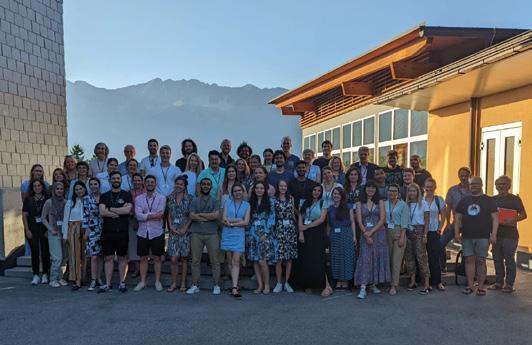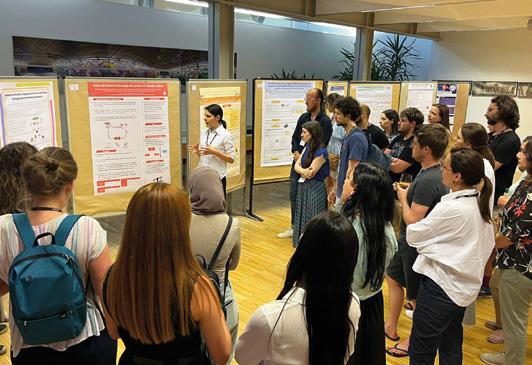
4 minute read
Celebrating Summer School
Innsbruck, Austria, 17−20 July 2022
Summarising the 2022 ESE Summer School in a few words is not an easy task, as many activities took place during those very rewarding days!
Advertisement
Our marvellous location was TBI-Grillhof, the Tyrolean Education Institute, which has unique panoramic views of the Nordkette and Serles, some of the most imposing mountains of the Alps. This contributed to a relaxed yet concentrated learning environment. It was the perfect place to deepen our knowledge and skills as well as to have fun − the best combination to support learning!
We enjoyed brilliant, interactive talks on fascinating topics, covering all the ESE Focus Areas, from clinical and basic research perspectives. We were privileged to learn from outstanding experts in their respective fields, who extensively reviewed the most important findings related to their topic, and showed impressive novel data, leaving our mouths open in awe. During the ‘group work breakout sessions’, attendees discussed their ideas on a given topic face-to-face with international experts.
But, hey, not everything was about work! The EYES Committee had organised many recreational and sporting activities for the attendees. These extended from going for a dip in the Lanser See Lake to a range of football and table tennis activities. I will never forget how shocking it seemed, to be able to look at the snow in the mountains while having a calm swim... And what’s not to like about a karaoke session?! I found singing together was a very good way to get to know each other a bit better.
Last, but not least, I would like to thank the Scientific Organising Committee on behalf of the EYES Committee and the ESE Summer School 2022 attendees: Professor Josef Köhrle and Professor Martin Fassnacht did such a fantastic job. We can’t wait for the next Summer School; more details will follow soon!
Juan Manuel Jiménez Vacas
UK

My highlights from Summer School 2022
I really appreciated Professor Ljiljana Marina’s discussion of progesterone and its link with the breast: from the physiology of the menstrual cycle to insights into natural and synthetic progesterone. To sum up: not all progestins are the same, pay attention!
Professor Franz Jakob’s explanation of the deep connection between muscles and bone health also caught my attention, including the major role of high impact exercise in the prevention of fractures, and how mechanical stimuli can result in hormone release.
Dr Ulrich Dischinger explained the role of gut hormones in nonalcoholic fatty liver disease, and how some well known drugs for diabetes, such as glucagon-like peptide-1 (GLP1) receptor agonists, may reduce inflammation and ameliorate liver function. The new gastric inhibitory peptide−GLP1 dual agonist may boost the hormonal network of these patients.
I also learnt about things I have never heard of before, like ‘tanycytes’ (I know you will Google it) or the skill of salamanders to regenerate their body parts endlessly.
One of the best aspects was the chance to get to know other young researchers from across Europe and beyond. It was a really great experience, even if it made me realise that I am not as good at tennis table as I thought…
Lorenzo Marinelli
Italy
Due to the wide variety of topics presented in the poster sessions, I could experience scientific progress in a multi-dimensional way, which helped me to develop a new idea for improving my experimental screening set-up.
Critical considerations regarding endocrine disruptors which may be present in laboratory equipment supported my ‘outside the box’ thinking. Talks were structurally organised to show how ideas evolved from the first experiments into final conclusions demonstrating how to coherently manage a scientific project.
I was eager to find the answer to one question that I had specifically asked myself before joining the Summer School, namely ‘how does the endocrine system function on a systemic level?’ Through participating in the School, I discovered how many functions of thyroid hormones are mediated through co-ordinated and synergistic interactions with the sympathoadrenal system. In pathological states, where either the sympathoadrenal or the thyroid system is fixed at a high or a low level, co-ordination is lost, with disruption of the physiology and development of symptoms. Emerging evidence suggests that disrupted interactions between the sympathoadrenal system and thyroid hormones contribute to explain metabolic variability. Finally, we saw recent studies, suggesting that the gut is an important reservoir for thyroid hormones and that it may also influence regulation of hormone activity.
Sanas Mir-Bashiri
Germany









